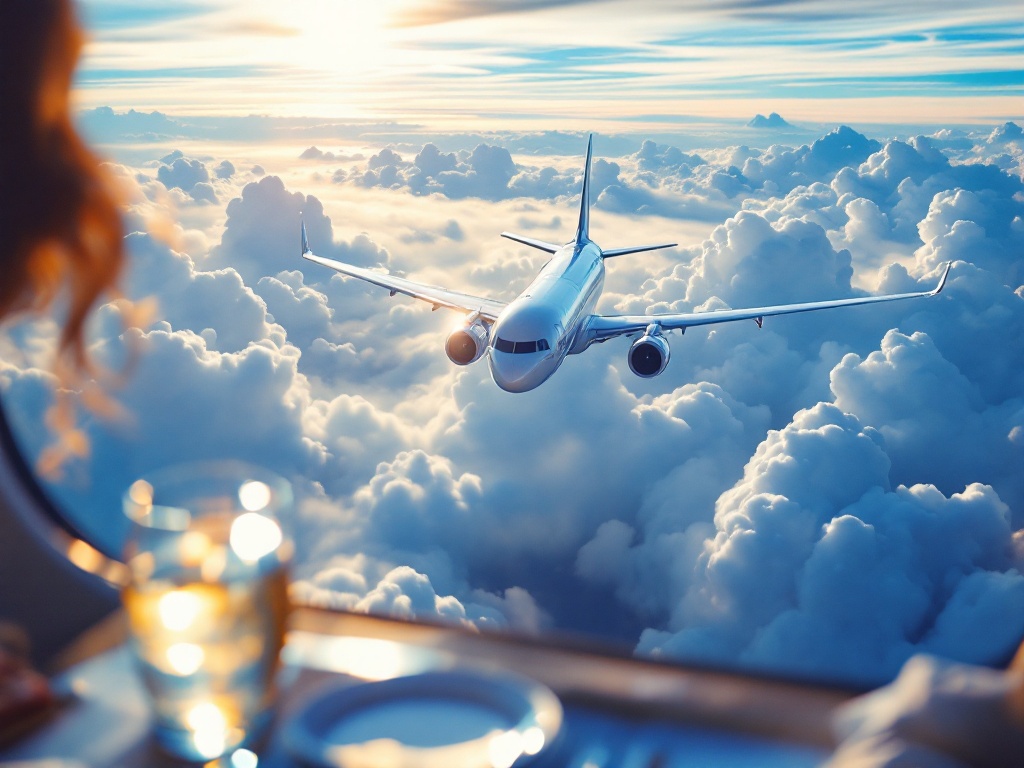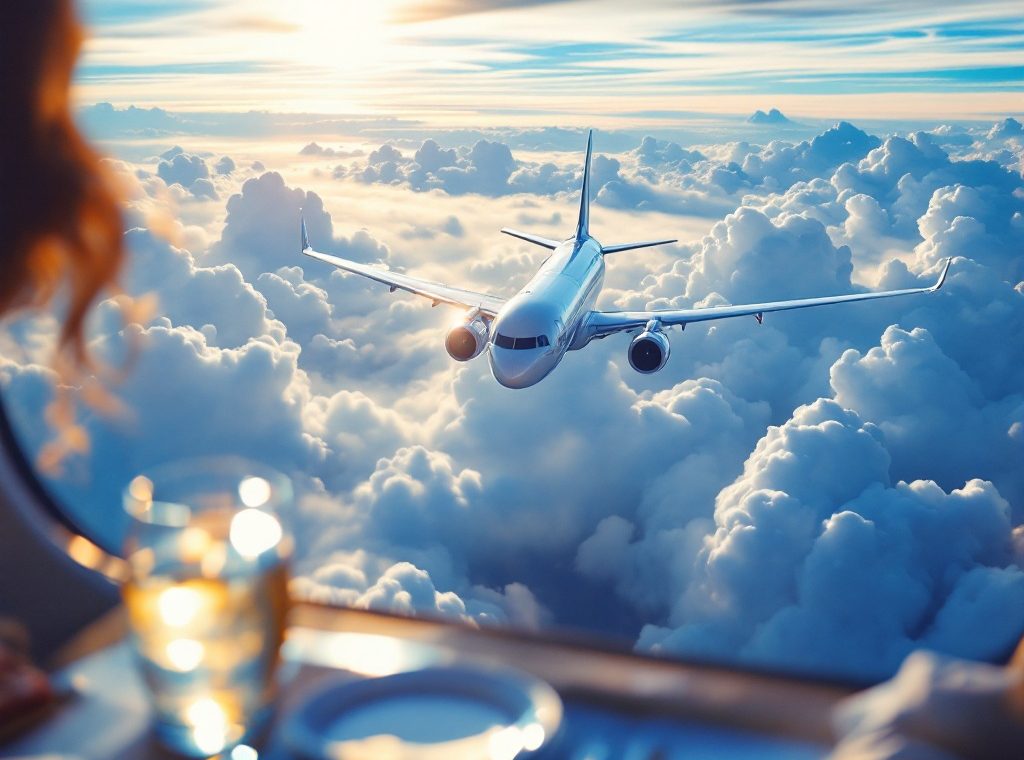Interesting Facts About Air Travel That Will Surprise You
Ever wondered why food tastes different at 35,000 feet or how planes withstand lightning strikes? Discover the science behind the unique culinary experience of air travel, where dry air and cabin pressure affect your taste buds. Explore fascinating safety facts, from rigorous maintenance protocols to the surprising frequency of lightning strikes. Uncover the secrets of airplane design, from the purpose of round windows to the role of winglets. Delve into the mysteries of ghost flights and the world’s longest and shortest routes. Prepare for takeoff and explore the intriguing world of aviation!
Important information

- Air travel is remarkably safe, statistically safer than car or motorcycle travel.
- Cabin air is a mix of fresh and filtered air, impacting taste and smell at altitude.
- Round airplane windows distribute pressure evenly, preventing cracks at high altitudes.
- The tiny hole in the window equalizes pressure between the cabin and the air gap, ensuring safety.
- Winglets, the upward extensions on wingtips, improve fuel efficiency by reducing drag.
Understanding the Air Travel Experience
Air travel presents unique culinary challenges. At 35,000 feet, the combination of dry air and cabin pressure reduces our ability to taste sweet and salty flavors by almost a third, making food seem bland. Despite this, airlines strive to create appealing meals. The cabin’s unique air quality, a blend of fresh and recirculated air, also affects how we experience food. Airlines carefully monitor this environment for passenger comfort.
Why Does Airplane Food Taste Different at 35,000 Feet?
At 35,000 feet, the dry, low-pressure environment of high-altitude air travel significantly impacts your sense of taste. This environment numbs taste buds, reducing their sensitivity to sweet and salty flavors by approximately 30%. Coupled with a reduced sense of smell, this diminished sensitivity makes airline food taste rather bland. However, airlines often counteract this effect by enhancing meals with more intense flavors.
What Is Cabin Air Quality Like?
Airplane cabin air is a blend of fresh outside air and recirculated, filtered cabin air. This mix, typically 50/50, maintains a comfortable environment while ensuring fresh air circulation. The filtration system effectively removes contaminants from the recirculated air.
How Do Oxygen Masks Work?
Releasing the mask activates a firing pin, which ignites chemicals that generate oxygen.
Fascinating Facts About Airplane Safety
Air travel has an excellent safety record, surpassed only by trains, and is much safer than driving or motorcycling. Research from MIT confirms this, indicating that flying is 20 times safer than traveling by car and 10 times safer than by motorcycle.
This remarkable safety level is achieved through several key factors:
- rigorous maintenance,
- highly trained professionals,
- comprehensive safety protocols.
Pilots undergo regular training, and planes are subjected to meticulous pre-flight inspections. Continuous advancements in aircraft technology and air traffic control further enhance safety.
Consider lightning strikes, a common experience for pilots. Aircraft are designed to withstand these strikes, allowing the electrical current to pass harmlessly through the plane’s exterior. Despite their frequency, lightning strikes pose minimal risk to air travel.
Why Flying Is the Second Safest Form of Transport
Air travel boasts a remarkable safety record, surpassed only by rail journeys. This exceptional level of security stems from stringent safety protocols, advanced technology, and the expertise of dedicated professionals. Aviation authorities mandate rigorous standards for aircraft maintenance, air traffic control, and pilot training. Sophisticated navigation systems and accurate weather prediction further mitigate risks. Pilots, air traffic controllers, and maintenance crews all undergo intensive training, minimizing potential hazards and making flying statistically safer than driving. These combined efforts contribute to the exceptional safety of air travel.
How Often Are Airplanes Struck by Lightning?
Airplanes are remarkably resilient to lightning strikes, experiencing them about once a year, or every 1,000 flight hours. This frequency underscores their robust construction. Lightning typically enters and exits through extremities like the nose, wingtips, or tail. The fuselage acts as a Faraday cage, protecting passengers and internal systems from the electrical current. So, although a lightning strike might seem alarming, aircraft are engineered to withstand these events.
What Happens During Engine Failure?
Pilots undergo rigorous training to handle engine failures, learning to maintain control with the remaining power and prioritizing safe landings. This preparation is essential for ensuring passenger safety and minimizing potential risks during such critical situations.
The Safest Seat on an Airplane
While plane crashes are terrifying, research suggests that sitting towards the back of the plane offers a slightly better chance of survival. This advantage is marginal, though, as the circumstances of each incident heavily influence survival rates. These circumstances include the nature of the crash and the plane’s location. Furthermore, the speed of the emergency response is critical. Ultimately, despite this small potential benefit of rear seating, flying remains remarkably safe.
Why Cabin Lights Dim During Landing
Dimming cabin lights during landing allows passengers’ eyes to adapt to lower light levels. This crucial safety precaution ensures clearer vision in the event of an emergency evacuation, potentially saving lives.
Intriguing Features of Airplane Design
Airplane windows feature a circular design. This shape evenly distributes pressure, preventing cracks at the corners, which are structural weak points under stress. The small breather hole you see equalizes pressure between the cabin and the air gap separating the window panes.
Airplane tires are incredibly durable, built to handle the extreme weight and high speeds of takeoff and landing. Inflated with high-pressure nitrogen, they resist overheating and bursting.
Winglets, those upward extensions on the wingtips, reduce drag and boost fuel efficiency by minimizing wingtip vortices.
Why Are Airplane Windows Round?
Airplane windows are round for a crucial safety reason: even stress distribution. This circular design prevents cracks, unlike square windows with their sharp, stress-concentrating corners. These corners become especially vulnerable at high altitudes, where pressure changes increase the risk of cracks and even window failure. Round windows are essential for maintaining the plane’s structural integrity.
The Purpose of the Tiny Hole in Airplane Windows
That tiny hole in airplane windows, often called a breather hole, plays a vital role in maintaining cabin pressure. Airplane windows have multiple layers with an air gap between them. The outer pane takes the brunt of the pressure difference during flight. The inner pane acts as a backup for safety, guarding against potential damage. This small hole equalizes pressure between the cabin and the air gap. This prevents the outer pane from cracking under the strain of high-altitude flight.
How Airplane Tires Withstand Extreme Conditions
Airplane tires endure incredible stress. Inflated with nitrogen at 200-300 psi, they support the colossal weight of an aircraft, far exceeding the pressure in standard car tires. These specialized tires are constructed from a unique rubber compound designed to withstand extreme temperature fluctuations. During takeoff, friction can heat them to over 200°C, yet upon landing, they can rapidly cool to sub-freezing temperatures. Multiple tires on each landing gear distribute the weight and provide redundancy, enhancing safety. If one tire fails, the others maintain support.
The Role of Winglets in Aircraft Design
Winglets, small upward-curving extensions on wingtips, minimize drag and boost fuel efficiency, contributing to more sustainable aviation practices. This seemingly minor modification has a significant impact.
Surprising Aspects of Flight Operations
Airplane flight paths often appear curved because the Earth is a sphere. The most efficient route between two points on a sphere is a curved path, known as a Great Circle Route, which saves both time and fuel. You might also notice “ghost flights”—empty planes traversing the sky. Several factors contribute to this phenomenon, including the need to reposition aircraft for maintenance, meet passenger demand in other locations, or fulfill contractual obligations with airports.
Why Flight Paths Aren’t Always Straight
The Earth’s spherical shape means the fastest flight paths are curved, called Great Circle Routes. These routes are more fuel-efficient than straight lines on a flat map because they follow the Earth’s curvature. A globe accurately shows the shortest distance between two points is a curve, unlike a flat map’s distorted view. This curvature saves significant time and fuel.
The Mystery of Ghost Flights
Airlines occasionally operate empty planes, often called “ghost flights“. This practice occurs for several reasons, including maintaining valuable takeoff and landing slots at congested airports. Relocating aircraft to meet operational needs is another factor. These flights are often mandated by regulations and are sometimes essential for smooth airline operations.
Record-Breaking and Unique Flights
Singapore Airlines boasts the world’s longest non-stop flight, an impressive 18-hour and 50-minute journey covering 9,537 miles between Singapore (SIN) and New York (JFK).
Conversely, the world’s shortest flight, operated by Loganair, links the Scottish Orkney Islands of Westray and Papa Westray. This quick hop spans a mere 1.7 miles and, under optimal conditions, takes only two minutes.
The World’s Longest Non-Stop Flight
Singapore Airlines Flight SQ24 connects Singapore (SIN) and New York (JFK), covering over 9,500 miles. This approximately 18-hour and 40-minute journey showcases advancements in ultra-long-haul air travel. While demonstrating this progress, the flight also presents unique challenges, such as maintaining passenger comfort and ensuring efficient operation. SQ24 also highlights the growing demand for direct, long-distance routes.
The World’s Shortest Flight
The world’s shortest flight is a brief hop between two Scottish isles. The Loganair route connects Westray and Papa Westray in the Orkney archipelago. The scheduled 1.7-mile journey typically takes about two minutes, though wind conditions can affect the flight time.
Aviation Industry Innovations and Trivia
ETOPS certification permits twin-engine aircraft extended travel from diversion airports. This enhances safety and allows for more efficient routes over oceans and remote areas.
Built with advanced lightweight materials, the 787 Dreamliner boasts improved fuel efficiency and a more comfortable cabin environment. Passengers enjoy higher humidity and lower cabin altitude, improving long-haul travel comfort.
How Extended-range Twin-engine Operations (ETOPS) Enhance Flight Safety
ETOPS certification revolutionizes twin-engine aircraft operations, opening up routes previously flown only by aircraft with three or more engines. This enhanced operational flexibility significantly improves safety. In the event of an engine failure, ETOPS-certified planes can divert to more suitable airports. Rigorous maintenance and close engine monitoring further bolster these enhanced safety standards. ETOPS contributes to both safer and more efficient air travel.
Exploring the Boeing 787 Dreamliner
Experience the revolutionary Boeing 787 Dreamliner, built with lightweight composite materials for superior fuel efficiency. Enjoy breathtaking views through larger windows, along with enhanced comfort from higher cabin humidity and advanced lighting. The innovative design also minimizes noise and turbulence, making your flight remarkably smooth and enjoyable.










